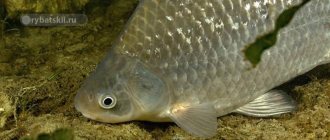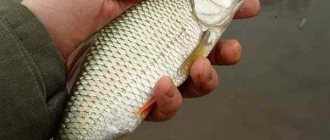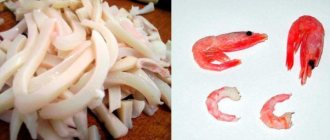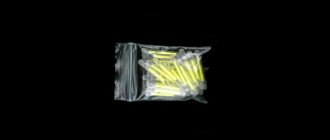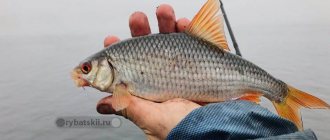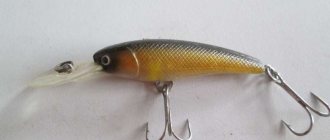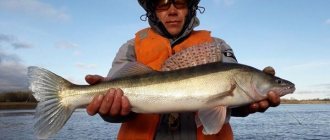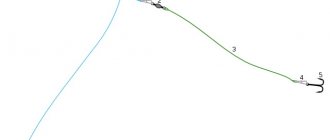Fishing: what kind of feeding is needed for crucian carp and how to fish for it
Those who love to fish are familiar with many types of fish. One of them is crucian carp. There are two known varieties of crucian carp - golden and silver. Golden crucian carp has a thicker back and a narrow belly, and the scales are smooth and quite large, with a copper and golden tint. Silver crucian carp have rough scales, with a lower body. The scales on the back of the fish are darker than those on the belly.
The reservoirs in which crucian carp live should have a bottom with silt and thickets with algae. These can be ponds, creeks, quiet rivers and lakes. Crucian carp eat algae, worms, insects and larvae as food.
If you plan to catch crucian carp on a hot summer day, then you should cast your fishing rod near snags and other shady areas near abandoned shores and piers.
Interesting facts about crucian carp
Crucian carp is a fish characterized by amazing resilience and adaptability. When the reservoir dries up in summer, this fish burrows into the muddy bottom, hibernates and waits for better times. When severe frosts come in winter, crucian carp can freeze in the ice, and when it melts, the fish comes to life again.
When the water begins to warm up with the onset of spring, crucian carp tries to stay closer to the shore. And already in June, this fish begins to spawn. You should go fishing for crucian carp with a simple fishing rod equipped with floats. Often they go for crucian carp with a donka or a winter fishing rod.
The bait used is earthworms, maggots, bloodworms, barley porridge, dough and bread.
Nodding tackle or jigs can be used. Crucian carp needs complementary feeding, and either proprietary mixtures, or peas, millet, or pearl barley porridge are used. All these baits must be flavored with sunflower oil and anise.
Fishing in spring
In the spring, you should start fishing for crucian carp in mid-April, and if the weather is cool, then you should postpone fishing until the end of the month. You need to navigate by the water temperature in reservoirs. The crucian carp comes out of hibernation when the water warms up a little.
First, the small fish wakes up, and only later - the larger crucian carp. When you intend to catch crucian carp, you need to understand that upon waking up, the crucian carp will go in search of food. Therefore, it is necessary to look for this fish in shallow water, where vegetation remains from last year. Crucian carp also look for larvae and other food near the banks and reed thickets, at a depth not exceeding 1 meter.
Time to bite
It has been noticed that crucian carp actively bites during sunset or at dawn. In the spring, you need to look for crucian carp along the banks near the vegetation, but not always in one place, since it also tends to move around in search of food. Then the fish goes to depth, and evidence of this will be bubbles appearing on the water surface. It is in those places where the bubbles come from that you should throw gear.
For spring fishing for crucian carp, a rod with a length of 5-6m is sufficient. It is advisable to use a plug type for these purposes, which is more convenient in overgrown reservoirs or artificial ponds. The fishing rod allows you to make precise casts without unnecessary noise. It makes it easy to hook and catch fish. The line on the rod should be within 0.14..0.16 mm without a leash.
The hooks used are number 10. The baits used can be the most common, but the best one is a dung worm. When a crucian carp gets hooked, it immediately begins to behave aggressively, so you should fish it out accurately and forcefully.
The fish should be pulled up and brought towards itself, and when the crucian carp appears at the surface of the water, if it is carefully brought into the landing net.
Spearfishing: choosing equipment for beginners
Fishing in the summer season
Summer fishing is more stable, except for June, when the fish spawn and almost stop feeding. But after spawning, crucian carp go hungry, when they bite all the bait and you can expect successful fishing.
Such spawning can take place several times over the entire summer season, after which the fish immediately begin to eat and actively bite. A good bite for crucian carp in summer will depend on the weather and the phase of its feeding. If the weather is rainy and prolonged, then the crucian carp is unlikely to bite.
Is crucian carp caught in winter?
The answer to this question directly depends on the condition of the reservoir and, accordingly, the method of wintering the fish. And yet, in most cases, winter fishing for crucian carp is possible. To do this, you can use ordinary fishing gear designed for representatives of the carp family of small and medium sizes, with the exception, of course, that fishing will be carried out exclusively by the bottom method.
As for tactics, there are two possible options - active search and preliminary feeding of the place. In the first case, the fisherman drills many holes in the ice one after another and, having completed several test leads in each of them, moves further until he discovers the school’s anchorage area.
In the second, using special devices (“dump truck”, “spring”, “watermelon”, “stocking”, etc.) or simply tightly rolled balls, bait is delivered to the bottom, for example, makukha. As the bait gets wet, it begins to spread around itself a trail of aroma that is attractive to the fish; as a result, the crucian carp, if it is not in a state of deep sleep, feels interested and rushes to the place of the intended feast.
Important! If a crucian carp spends the winter hibernating, burrowing into the mud, it completely stops feeding and, accordingly, will not be caught.
In general, both described methods have proven themselves equally well, so a fisherman can choose any one for himself, guided by his own ideas about the most comfortable pastime (some people like active search, since it involves constant movement and does not allow them to freeze in severe frost, others prefer dress warmly and sit comfortably at the hole).
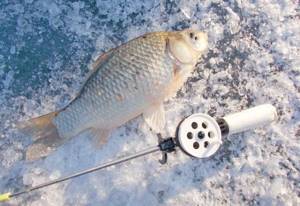
Carassius is considered one of the most frost-resistant fish in the freshwater category, but another relative of the carp, Cyprinodon macularius, is rightfully considered the record holder for its ability to withstand heat. This small fish lives in hot springs in California, where the water temperature rises to +50ºС and above.
Fishing for crucian carp in autumn
As a rule, the best time for catching crucian carp is considered to be the end of spring - the beginning of summer, that is, the first days of May, and this is usually true. Catching crucian carp in the spring, before spawning, when the ice melts and the fish are hungry from winter, is rarely unsuccessful.
After spawning, crucian carp also bite well, the fish is hungry, with a belly freed from eggs, and is usually voracious, but it is not always possible to determine this end of spawning.
The fact is that crucian carp spawns in portions, in several stages, the interval between which is determined by the temperature and water level in a particular reservoir.
The faster the temperature rises and summer comes, the faster the fish “shoot”, otherwise, that is, when summer is in no hurry to take over, the spawning stretches out, which is why it happens that in one place the crucian carp has already spawned and is actively biting , and in another, not so distant one, it is still spawning, which is fraught with a very short and sluggish summer bite.
At the end of summer, when the crucian carp has finally spawned, its bite more or less “settles down”, and Indian summer, that is, the end of September, usually pleases with a good bite.
Many fishermen know about this and use it, but few know that fishing for crucian carp in late autumn, right up to the freeze-up, can also be very productive.
Moreover, in some reservoirs, crucian carp can bite even after the ice has formed, and sometimes almost all winter, it just bites very sluggishly and carefully, so catching crucian carp in winter is associated with some difficulties, and is not always advisable. Now we will talk about fishing in the pre-winter period.
So, for such a difficult goal as catching crucian carp in November, the first thing you need is reconnaissance. As already mentioned, crucian carp do not bite equally everywhere and always, especially in such difficult times. To find a suitable body of water, you will have to tinker a lot.
You can, of course, do it entirely on your own, methodically fishing reservoir after reservoir, but it is best to exchange information with other fishermen, communicating with friends or on forums. The best people to predict the behavior of our “client” are fishermen, who are called “crucian fishermen.” Representatives of this caste ate the dog while fishing for this particular fish, many even more than one.
They specialize exclusively in catching it and consider a reservoir to be fishless if there is no crucian carp there. In general, when choosing a place for such a purpose as fishing for crucian carp and crucian carp in the fall, it is best to rely on information from crucian fishermen.
If no reliable information has been received, then it is better to choose reservoirs in which nothing else is found except crucian carp, or fee-paying carp fish, but only if the ubiquitous trout does not live there, and of course one cannot help but rely on luck, in this period, in half the cases it is this that influences the outcome of fishing.
So, let’s assume that we have found at least a suitable reservoir; now the second most important event is choosing a location. Finding a place to fish can be difficult. Crucian carp is not a gudgeon that darts around the entire pond.
With colder weather, almost all carp fall into an energy saving mode: they move less, save calories, are not so actively looking for food, picking up mainly what lies right under their nose, and therefore catching crucian carp on a lake or pond is practically in no way depends on the bait.
In the current, odors, of course, will spread faster than in stagnant cold water, but even having smelled the bait, the crucian carp will most likely simply ignore it, and will be too lazy to swim after it, unless it lies a couple of meters away from it.
As a result, since the crucian carp does not want to move, we will have to climb the reservoir; we can start from summer places, that is, next to aquatic plants, and if it is quiet there, then gradually descend into the depths and look for holes.
A hole 20-30 centimeters deep can be considered a hole, since generally in large reservoirs favored by crucian carp, the bottom topography is quite uniform. In the area of a larger and deeper hole, a whole flock can gather for the winter, since crucian carp mostly migrate to the holes to spend the winter.
In detecting bottom irregularities, a depth gauge with a heavy sinker helps well, because all the depressions in crucian carp reservoirs are silted, and it is not always possible to accurately probe the bottom with a light weight.
If your target is a large crucian carp, then you can throw away the shallows immediately, when it gets colder, it doesn’t go there, there’s simply nothing for it to do there, the green shoots that they often eat are no longer there, and there are no living creatures in the cold coastal waters anymore. So all that remains is the depth, where catching crucian carp on a feeder can be quite effective.
Weather
So, we decided on the place. The next risk factor that you should pay close attention to is the weather: temperature, atmospheric pressure and, perhaps most importantly, wind.
The direction and strength of the wind should be taken into account first of all, because the wind can drive the crucian carp to another place or even discourage it from biting. Let's say a warm, constant wind forces you to choose the surf shore, the crucian carp is drawn there.
We must also remember that the wind is not a tram, and it is not difficult for it to change direction. A sudden strong cold wind can take away any appetite from a crucian carp, or simply force it to move to a depth where the water is calmer.
If the weather remains relatively calm and constant for a long time, then crucian carp is caught well until the freeze-up, gradually sliding deeper and deeper, towards the wintering pits.
Lure
Having figured out where to fish, you should decide on bait. As a rule, there is not much use from it. It won’t be possible to lure crucian carp from far away, but if the fish is hanging around nearby, you can at least stir it up and provoke it to bite. It is better to feed with a small amount of feed mixture, which should first be “unboiled” in half with soil from the reservoir.
First, we’ll mix the soil with water until it becomes a monotonous porridge-like muck, and then we’ll add dry “rations” to it. It’s also a good idea to add some living component - maggots or bloodworms (frozen fish, which require a lot of energy, treats high-calorie live food very favorably).
For starter feeding, you can use almost the entire volume of bait, because crucian carp do not treat additional feeding during this period very well, and may completely refuse to bite.
Bloodworms can be a very effective bait at such times. The fish reacts well to it, but larvae can only be used if there is no current and the depth at the fishing site does not exceed a couple of meters.
Otherwise, the larvae will spread out and the fishing area will be “washed out.”
If you use clean bloodworms, you should first soak them in water, otherwise they will not sink, but will spread across the surface of the water and sink to the bottom who knows where, but we don’t need that.
Almost anything can be used as bait in the pre-winter period. Crucian carp, which in normal times is mischievous, closer to winter eats everything you can offer.
This can be pearl barley, semolina, maggot with bloodworms, as well as a variety of “sandwiches” or dough with small additions of flavorings.
Sometimes an ordinary earthworm shows itself best, not a red dung worm, but a simple earthworm, preferably dug up somewhere in a reservoir. If you have the opportunity to use a caddisfly, then you should try to catch it, sometimes it turns out well.
Catching crucian carp with a fishing rod
Fishing for crucian carp does not require any special gear. You don’t need ultra-light bleak fishing rods, nor, vice versa, super-strong heavy carp “clubs”. So there’s no need to worry too much about this.
Catching crucian carp with a float rod is more effective when you use a plug rather than a fly rod. A fly fishing rod is only suitable when the situation on the battlefield is calm - there is no waves or wind, otherwise the bait is constantly blown away, and every now and then you have to re-cast it.
Recasting scares the fish, you have to wait until it calms down, wasting time, and besides, the fish does not always have time to calm down before the next recast, and therefore fishing with a fly rod can turn into continuous stupid casts.
Peculiarities of fish behavior under ice
Winter fishing tactics are greatly influenced by the behavior of the fish itself, which has its own characteristics in a frozen body of water. Crucian carp, like all other inhabitants of the aquatic world, are not very active in winter; moreover, it is this representative of the cyprinid family that is particularly lethargic, bordering on a state of complete hibernation.
Find out what time is best to fish for crucian carp.
Since autumn, with the first frosts, individuals of the genus Carassius look for the most suitable place for wintering, settle down there and practically do not move anywhere. And since the criteria by which a site is selected are quite objective (as a rule, this is the deepest area or underwater hole), usually a huge number of crucian carp gather in a small area.
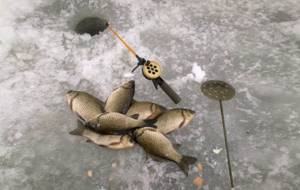
Understanding this subtlety greatly simplifies, but at the same time complicates the fisherman’s task: with a good knowledge of the bottom topography, the hunter can with a high probability detect an area of high concentration of fish and, if he is lucky with such a find, is almost guaranteed to remain with a good catch throughout freeze-up period. On the other hand, expecting a bite in a place where there are no crucian carp is a dubious prospect, even when using abundant bait.
It is best to catch crucian carp directly in the wintering pit with light tackle ( a float rod with a short leash or a bait with a jig ), aimed at biting with the nozzle raised slightly upward. This is exactly what the sluggish winter crucian carp does with its prey - it tastes the snack with its lips for a long time, and then, finally taking it into its mouth, it floats up a little.
At the same time, the side nod slowly rises, and the float takes a horizontal position. Having noticed such a signal, you need to take a short pause and only then perform the hook. To increase the information content of the tackle, it is recommended to calculate the depth in such a way that the nozzle barely touches the bottom, and the fishing line always remains taut.
Important! In winter, crucian carp do not rush to feed greedily; the fish are rather picky and picky. Therefore, the bait should be fresh and varied; it is also good to use several baits at once, making so-called sandwiches out of them.
As the ice begins to melt, crucian carp are removed from their wintering area and begin to gradually rise a little higher in the water column, although they still do not travel long distances. This change in behavior is facilitated by hunger gradually making itself felt, driving the fish to an active search for food.
During this period, by the way, the likelihood of encountering a bite from its larger relative, the carp, in a place where crucian carp is fishing increases. This fish has approximately the same habits, but carp is much stronger than crucian carp and fights much more fiercely for life when hooked, so tackle not designed for such resistance may not withstand the pressure and break off.

If the weather in winter is changeable, severe frosts alternate with thaws, causing the ice to melt and the water level in reservoirs to rise, and also in places with running water, crucian carp behave a little differently. The fact is that the described weather conditions lead to the subsidence of the ice layer into the lower layers of water, and this, in turn, forces the fish to leave the chosen wintering place and move to longitudinal deep ditches.
Other inhabitants of the water world unconsciously rush there, creating bustle and active movement. All this forces the crucian carp, which is usually lethargic in winter, to wake up from a half-asleep state and show interest in the food around it, including that raised from the bottom as a result of the turmoil created around it . For a fisherman in such a situation, fishing tactics also change dramatically. It is not at all necessary to purchase high-quality animal food for bait; a “revived” crucian carp can briskly peck even on a baitless jig.
Did you know? Carassius has been the subject of long-standing interest from plant breeders. Based on it, many interesting varieties and hybrids with the most intricate shapes and colors have been bred, but perhaps the most famous of them is Carassius auratus, better known as the goldfish.
For example, a very good option would be to use two small “devils” with a pair of reliable hooks on each. The movements should be performed slow, smooth and wide, with a pause at the top point and subsequent slow lowering.

It is important to remember that “stray” crucian carp, unlike “sleeping” crucian carp, can bite not only at the bottom, but also in higher layers of water, so it makes sense to constantly change the depth during fishing.
November crucian carp
Among the most persistent legends that exist in the fishing community is the legend of crucian carp, which, with the first cold weather, buries itself in the bottom silt and goes into hibernation, like a forest bear...
This legend has long been cracking under the pressure of numerous facts, but it holds.
Crucian carp on the first ice
In reality, crucian carp do not always go to bed for the winter and not everywhere. There are reservoirs with warm water that do not freeze even in winter. There are many freezing reservoirs where the layer of bottom silt is small. There is simply no place for crucian carp to burrow there. And the heat-loving creature has to look for food for itself all winter.
| There is a stereotype among fishermen that crucian carp hibernate in winter. But this is true only for some reservoirs, and even in them crucian carp can fall into a stupor in a secluded corner, not really searching for food. But there are places where crucian carp are active all winter, and you can fish all the way to the ice. In general, this fish is not a predator, so it chooses water bodies with rich vegetation - it is easier for it to hide in this. The deeper the reservoir and the fewer predators there are, the more likely you are to catch larger crucian carp (on average, crucian carp weighs about 700 grams). In autumn, crucian carp accumulate fat for the winter. The zhora period is quite short: from late September to early October. The best time of day is between 10 am and 5 pm. Feeding and bait for autumn crucian fishingAs a rule, in water close to zero temperature, crucian carp are so inactive that they will not respond to bait. In such cases, you should hope for luck: if you cast a fishing rod approximately in the area where the school is drifting in a half-asleep state, the crucian carp will bite. If you are lucky and you find those very active flocks, then bait will not hurt. Millet cooked until cooked and universal complementary foods are perfect. It has a specific pleasant smell that will attract crucian carp. For bait, feel free to take a worm, bloodworm, maggot, or hominy. The question arises: what to use to catch crucian carp? The best option would be either a float rod or a feeder.
Catching crucian carp in late autumn with a float rodIf we talk about a float rod, then it is convenient for quick and deft hooking, because the crucian carp will not swallow the bait completely. The commonly used equipment can be divided into two types. The first is a float rod with a regular fixed float. We select the length of the rod in accordance with the casting distance: from 4 to 7 meters. The second type of equipment involves the use of a sliding float and a reel: the float slides freely along the fishing line, the depth is adjusted by a rubber stop. By the way, the fishing line should be 0.15-0.17 mm, and choose a thin leash: 0.06-0.12 mm. Fishing for crucian carp in late autumn on a feederAnother fishing option is with a feeder (using a rod with a large number of small guides on low holders and feeders to attract fish). This method cannot be used everywhere: the abundance of aquatic vegetation can seriously interfere. In our case, the chances of success are greater: by late autumn there is rarely enough vegetation left to make fishing on the feeder difficult, and by this time crucian carp prefer to stay in deep places that are clear of algae. Since you will not catch crucian carp weighing more than 2 kilograms, you should choose the thinnest and lightest elements of feeder equipment. This fish rarely catches itself, so the feeder must be very sensitive, and you should not catch more than 3 at the same time. But what will make the work easier is that crucian carp loves a variety of baits. Therefore, in order not to take risks, take a large set of baits with you when fishing and experiment! You can’t easily guess what he likes today: corn, worms, bread pulp, bloodworms, dough, maggots... Compared to fishing with a float rod, it is easier to catch larger crucian carp with a feeder. The frequency of bites using a feeder is higher, because the feeder is next to the nozzle, and one area is fed. On the other hand, soft baits cannot be used with it, and at shallow depths it will create too much noise. about autumn fishing for crucian carp on a feederTherefore, choose a method to your taste and try different things - this is the only way to get pleasure and experience! Related articles: Catching crucian carp with a nipple or plug Fishing for crucian carp in spring - bait, tackle, baits Catching crucian carp with a float rod |
| A completely new activator! 100% ORIGINAL! This bait has not yet been banned by the Rybnadzor! |
Where to look for crucian carp in November?
On the first November ice, when its thickness reaches 8 cm, the greatest activity of crucian carp is observed. Crucian carp bite from the ice during the first two weeks from the moment a reliable layer of ice is established on the reservoir.
If you study the reservoir in advance, during the open water season, you can avoid unnecessary movements on the ice in search of a good place to catch crucian carp. Crucian carp is a heat-loving fish. In any case, he will look for the warmest water in the reservoir.
The lower the air temperature above the surface of the reservoir, the greater the depth the crucian carp will be. (Although there are exceptions. For example, a reservoir feeds on cold underwater springs. Crucian carp will try to avoid “wells.” And you will have to look for crucian carp at other depths.)
Important to know (statistics)! The ratio of the influence of fishing conditions on the final catch:
- Stable weather - 15%;
- The right gear - 25%;
- Correct bait - 60%.
It is the correct bait that is decisive in the size of the catch. Remember this!
And, conversely, during the thaw, crucian carp will move closer to shallow water. Therefore, it would be good to imagine the nature of the bottom in the reservoir where crucian carp fishing is expected.
For example, crucian carp likes to stay on the border of dry reeds and open water. But, if in some part of the reservoir there is a relatively deep (up to 3 meters) snag hole, then the crucian carp will prefer to stay in a school in this particular place. Of course, there will be bites from the reeds, but much more careful than in the snags.
It is worth looking for open or unauthorized waste drains in a body of water. In such an “aryk” the water is always warmer and there is something for hungry crucian carp to snack on.
If we talk about reservoirs with a current, then the crucian carp here tries to stay in places where the current is weak or completely absent. It’s good if these conditions are combined with bottom snags or some other shelter.
But, to be honest, fishing on the river in November is still quite a dangerous undertaking. In recent years, ice has formed on rivers quite late.
What gear should I use?
Most often in November, crucian carp fishing is carried out using winter float equipment. The equipment of a winter float rod for catching crucian carp includes:
- Fishing line up to 0.15 mm thick. It would be good if the fishing line was inconspicuous and made of fluorocarbon;
- A small jig made of lead or tungsten. It is difficult to recommend the shape of the jig. You will have to select, adapting to the characteristics of the reservoir;
- An additional leash with a small hook, which is installed on the main line above the jig;
- Some fishermen treat jigs with attractants. For November crucian carp, the garlic smell and aroma of crushed bloodworms may be of interest.
Not only a float, but also a nod (guard) can serve as a bite alarm in such gear. Both elements of equipment have their pros and cons.
What bait should I use?
Bloodworms were, are and will remain a universal bait for any fish during ice fishing. Crucian carp in November also favors this type of bait.
A bunch of bloodworms on a jig hook and an additional leash can whet the appetite of crucian carp. But, besides bloodworms, there are other baits that are quite acceptable for crucian carp. For example, the same red worm or maggot. Baits of plant origin work poorly in November and not on every body of water.
Fishing tactics
Crucian carp in each reservoir has its own unique behavioral characteristics. It is difficult to recommend any specific actions that can bring guaranteed success. But a few tips can be given:
- It is necessary to drill about twenty holes and almost constantly move between them.
- Try to fish at the very bottom, at a distance of about five centimeters from the ground.
- If there is no bite during the first behavior model, then the main emphasis should be on the hook mounted on an additional leash. In this case, when casting the bait, you need to calculate the depth so that the jig hits the bottom and raises a small column of turbidity.
There is no need to specially feed November crucian carp.
In conclusion, I would like to remind you once again that each body of water is unique in its own way. The behavior of crucian carp in each of the reservoirs is also unique. In order to catch crucian carp during that short period of the November first ice, when it is especially active, you will have to do reconnaissance, select gear, and find out the taste preferences of the fish.
Catching crucian carp in November is hard, but very exciting work. The fisherman will have to think a lot and move quite a lot. Not every angler can handle this job. But if he can overcome himself, he will be left with both the catch and the most vivid impressions. And what could be better than impressions?
Hello guys! My name is Anna Ponomareva, I am a fisherman's wife. Actually, I’m not very good at fishing, but there was a time when I caught the most! One day we went fishing with a large group and had a competition to see who could catch the most. My friend Zhenya said (privately) that she had a “secret weapon” and gave me a small bag of liquid. As it turned out, it was the Fish Hungry attractant. So, thanks to the combination of a successful wobbler and Fish Hungry, I even managed to catch a friend! The 11.8 kg catch was caught in 2.5 hours! My husband was completely bewildered, but I never told him about my “secret weapon.”
I found out where Zhenya buys bait and have already placed 2 orders! Follow the link - this is the official store, order only here!
Source: https://vlunke.ru/noyabrskij-karas/
When does crucian carp go to winter?
Among “old school” fishermen, there is a firmly established opinion that crucian carp spend the entire winter in deep hibernation, like bears, only instead of a den, the fish uses a soft layer of silt, into which it buries itself, like in a warm blanket. In reality this is not entirely true.
In a small closed (still) pond or shallow lake, where due to the shallow depth at low temperatures the water completely freezes in winter, the fish really have no choice but to lie on the bottom and wait for warming in a state of suspended animation.
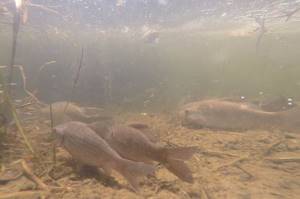
It is interesting that during such wintering, river inhabitants often find themselves deeply and firmly frozen into a layer of ice, but with the advent of a thaw they miraculously come to life. This trick, however, is not available to all fish, but only to the most frost-resistant and hardy species.
In addition to crucian carp, this list includes the sleeper firebrand, tench, carp, as well as the pike’s closest relative - the common Dallia pectoralis, also known as black fish. It turns out that the blood of these fish contains special antifreeze substances that significantly reduce the freezing point of their body. Of course, if the ambient temperature drops too much and this barrier is crossed, the fish will die.
Did you know? There was a recorded case when a hungry dog grabbed a piece of ice with a black fish frozen in it with its teeth and swallowed it whole, but after choking, after a while, spat it back out. The thawed fish, which had not previously shown any signs of life, desperately struggled in search of saving water.
In deep reservoirs, as well as in regions with a mild climate, crucian carp can easily spend the winter in an active state. A certain average variant of fish behavior in winter is also possible, in which it chooses the deepest place in a reservoir with the warmest water possible (the so-called wintering pit), where it spends time almost completely motionless, but from time to time it still “wakes up” and even starts searching stern.

The specific time for crucian carp to go into hibernation depends on the size of the reservoir and climatic conditions, but in any case, before the upcoming cold weather, the fish needs to thoroughly replenish the reserves of nutrients in its body.
It is for this reason that late autumn is considered one of the best periods for catching this freshwater inhabitant, and when it comes to bait, the fisherman should give preference to animal (maggots, worms, etc.) rather than plant food, as it is more nutritious and high in calories. It is precisely this kind of bait that crucian carp rush with particular greed on the eve of the beginning of winter.
crucian carp
There are two types of crucian carp: golden - with a round, high body, living in reservoirs with stagnant water (ponds overgrown with mud), and silver - with a lower body and light scales, inhabiting not only lakes, but also rivers.
Crucian carp are widespread in the reservoirs of our country, absent only in the extreme northern and northeastern regions. They are very unpretentious of oxygen in water. They tolerate cold winters and hot summers well. Goldfish are especially hardy.
White or silver crucian carp (often Amur, found in rivers and lakes from cultural fish farms or introduced according to a plan for stocking reservoirs) occupies a variety of places: quiet reaches of rivers, zones of coastal algae, willingly enters oxbow lakes and bays, and often remains after floods in flooded lakes and even pits, where they often die by drying out. Silver crucian carp is less tolerant of oxygen deficiency than gold carp. The crucian carp has well-developed skin respiration, so it survives in conditions in which other fish usually die.
Silver crucian carp, unlike gold carp, has a silvery belly, a larger number of gill rakers, as well as a more notched caudal fin, highly jagged, non-branched rays in the dorsal and anal fins, and differs markedly in biological characteristics. The dorsal fin of both crucians is long, slightly rounded at the apex.
Selection of tackle, baits and baits
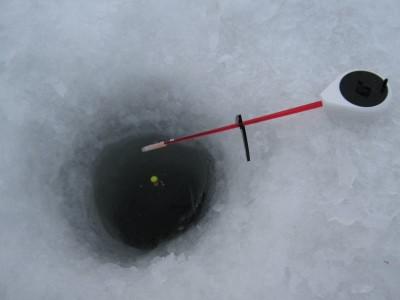
The jig is used more often. When choosing this tackle, keep in mind that crucian carp bite well on dark and silver colors (they bite well on tungsten). The deeper the reservoir, the brighter the jig should be (for example, red, like a bloodworm). On a clear day it is better to use a dark jig. The maximum thickness of the fishing line is 0.14 millimeters, the minimum is 0.08 millimeters (diameter). For winter, it is recommended to buy a fishing rod with legs. Thanks to the legs, the tackle will not be dragged under the ice and you will not have to hold it in your hands all the time, but can be fixed at the hole.
Interestingly, he disdains unpresentable-looking bait, so the bloodworm must be changed quite often. Worms (earthworms, dung) are also a favorite delicacy of crucian carp. This treat is prepared for him by fishermen in the fall. To store worms you need a box with soil, which must be watered regularly .
Another bait option is dough. Flour for it should be coarsely ground from wheat or rye. An egg yolk will add attractiveness to the dough; you can flavor it with honey.
In low temperature conditions, the dough may freeze; it is better to put it in a syringe and put it in your pocket before winter fishing until required.
This fish also loves maggots, oatmeal or semolina. A delicacy for this individual is the larva of the burdock moth.
Crucian carp respond well to bait at night, but during the day they can be afraid of it. Many fishermen wonder: what to feed crucian carp in winter? You can use breadcrumbs as bait, the main thing is not to overdo it: in winter the fish eat little, and a well-fed fish will not hook you. If the depth is shallow, winter feed for crucian carp is poured in small portions into the hole, stirring, for example, with a stick. Where the current is strong or very deep, it is recommended to use a feeder. In a strong current, its opening will be at the bottom, and if the water is standing, there will be several meters between the feeder and the bottom.
Features of winter fishing
Hunting crucian carp in winter is not easy. You need to know his habits and behavioral characteristics; understand how the weather affects his activity; be able to stir up lethargic fish, select catchable gear, fishing techniques and bait.
Where do they catch crucian carp in winter?
Fishing for crucian carp from ice is not possible in all bodies of water. In shallow ponds, swamps, fronds and quarries with a muddy bottom, which are abundantly overgrown with algae in the summer, the fish burrows into the mud and spends there all winter. This allows her to survive the difficult time associated with unfavorable oxygen conditions.
Successful fishing is possible in reservoirs with medium and deep depths. Here crucian carp are comfortable in winter; they do not feel extreme cold and lack of oxygen. Therefore, you need to fish on lakes and ponds with depths of 2–6 meters, a hard bottom, and large areas of algae-free water.
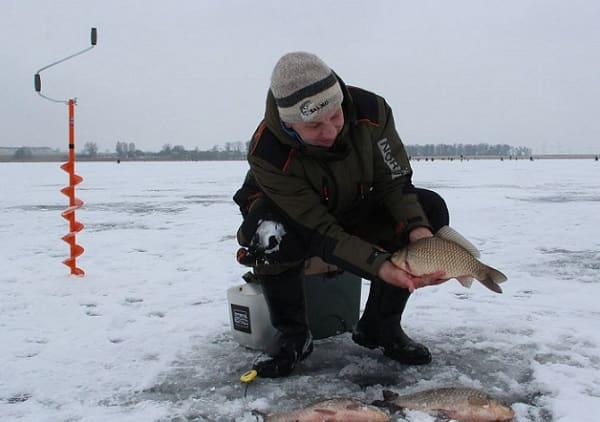
Please note: Additional advantages of the reservoir are the presence of springs gushing from the bottom and small streams and rivulets flowing into it.
In the backwaters and oxbow lakes of large rivers and reservoirs there is also a high probability of encountering crucian carp. This river species of fish can be caught throughout the ice fishing season, even in the dead of winter. Moreover, the catches include large and trophy specimens.
Why crucian carp “can’t sleep”
Hibernation is a certain protective reaction of fish in order to survive in winter in difficult conditions, when the oxygen concentration in the water decreases to the limit. This is how different representatives of the ichthyofauna behave - crucian carp, carp, tench, loaches, rotans.
In those reservoirs where there is a favorable oxygen regime, a hard bottom, and a rich food supply, there is no point in crucian carp burying themselves in the silt and going into “sleep” mode. It is quite active, moving around the water area, looking for food and competing for it with other representatives of the ichthyofauna.
Recommended reading: How to catch bream on the river in winter
Weather and bite
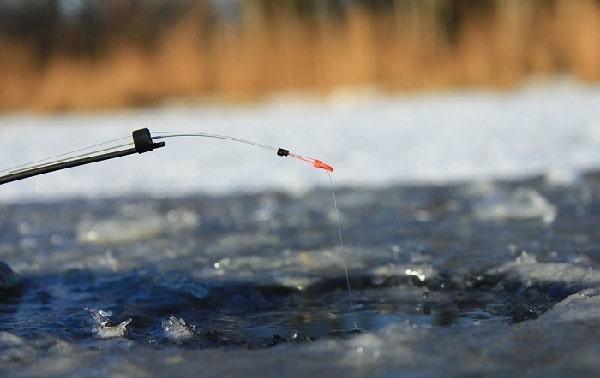
It is best to catch crucian carp in winter on the first ice, when the temperature is slightly below zero and the thickness of the ice cover reaches a safe 7 cm. Therefore, the first two to three weeks of the season bring stable catches.
In the dead of winter, the bite of crucian carp almost completely stops. Sometimes it is possible to catch fish when there are thaws with air temperatures of 0–+2 degrees. With the last ice, the fish become more active, but the catches are not stable, as at the beginning of winter.
In general, the “fat man” likes stable weather without sudden changes in atmospheric pressure at an air temperature of -7 - +2 degrees, in cold weather it hardly bites, with a light breeze or calm, and no precipitation. Can be caught on sunny and cloudy days.
Fish activity during the day
Crucian carp bite better in the morning and evening hours. The first captures of individuals occur at sunrise. Then activity drops, contacts become rare and uncertain. After lunch, the fish's appetite gradually increases, and it begins to take bait before dusk. In some reservoirs, crucian carp actively feed at night.
Express tips for winter fishing
- In winter, crucian carp bite well in reservoirs whose bottom is not covered with a thick layer of silt. This fish loves oxygenated water, which means that water must enter the reservoir from outside (river).
- In winter it is better to fish with a jig.
- The bait should be attractive to crucian carp both in appearance and smell (several bloodworms, dough with honey, etc.)
- You cannot sprinkle a lot of bait for crucian carp in winter. At this time of year, they quickly get enough and go home, ignoring the baited fishing rod.
- Fishermen consider the active fishing technique to be more effective: periodic movements need to be made with a jig.
- At the slightest movement of the nod , you should hook without hesitation.
- in bad weather .
- In reservoirs with a large layer of silt at the bottom, crucian carp hibernate ; they wake up in the second half of April.
- In February, there is a good bite during thaw periods.
- For more effective fishing for crucian carp in winter, it is recommended to explore the pond in the warm season and notice the depressions in the bottom - this is where you need to look for crucian carp during winter fishing.
What to fish with
Fishing for crucian carp in winter is carried out with classic nodding or float rods. Fishermen use jigs and bare hooks, and use various baits, mainly of animal origin. Some "penguins" feed the holes to activate the bite.
Tackle for winter crucian fishing

The gear for hunting this representative of the ichthyofauna is light. The fish is cautious, carefully tries the bait, and behaves suspiciously towards everything unfamiliar. A set for fishing crucian carp in winter consists of a fishing rod, fishing line and bait.
A winter fishing rod for crucian carp should be light. Its length can be 30–50 mm. You can use regular “balalaikas” or “fillies”. Some fishermen make their own rods, turning the body out of compressed foam, and use the tip of a summer float rod made of fiberglass or carbon fiber as a whip.
The fishing rod is equipped with a small reel, on which you need to wind about 10 meters of monofilament fishing line with a thickness of 0.08–0.14 mm.
The thinner the thread, the more invisible the tackle will be and the better the bite, but the likelihood of the bait breaking while fishing increases.
A nod is installed on the whip. It is better to take an inexpensive lavsan gatehouse, adjustable in length. Some fishermen make them themselves from a plastic bottle, x-ray film, boar bristle, clock spring and other materials.
Recommended reading: Don Ruff
When fishing with winter float rods, it is not necessary to use a guard, since the fish bite is recorded by the float. It is advisable to install a light bite alarm that will not alert the fish when it tries to bait the bait.
An interesting video about winter fishing for crucian carp on the lake. Uelgi in the Chelyabinsk region.
Bait and groundbait
When fishing with jigs, small models weighing up to 0.3 grams are used. Shots, droplets, ants, nymphs and uralks have proven themselves well; in some reservoirs the fish take on goats and devils.
When determining the color of the jig, it is necessary to take into account the nature of the bottom, lighting, and weather factors. The universal and most catchy colors are black, gold and silver. Sometimes bright light green, yellow and orange shades or fluorescent colors work.
Among the natural baits in winter, it is recommended to use bait of animal origin:
- bloodworm;
- small earthworm;
- burdock moth larva;
- maggot;
- Amphipod.
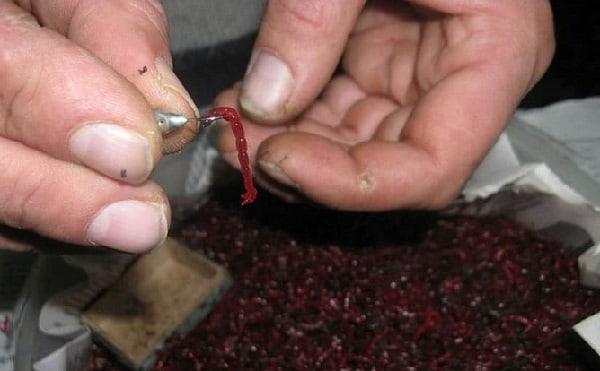
Bloodworms are the best bait. You can put one or a bunch of larvae on the hook.
For reference: On some reservoirs, crucian carp respond to plant baits in winter. The best of these attachments is dough with the addition of honey.
It is not necessary to feed the crucian carp. It does not migrate across the water area, so it does not need to be kept at the fishing point. The main thing is to find a promising area and carefully examine it. Bait can be used to further attract the attention of the fish. Use any universal summer or winter mixtures. The presence of live food (mormysh, bloodworms) additionally attracts fish, often increasing its appetite.
Fishing methods
There are two main ways of catching crucian carp on the first ice - passive and active. With the first one, the angler simply lowers the bait to the bottom, places the fishing rod permanently and begins to wait for a bite. Contact of the fish with the bait is indicated either by a float or a nod.
The active method involves working with bait. The fisherman lowers the jig to the bottom and begins to shake the rod, slowly lifting it up. At the top point there is a pause. Then the cycle repeats. By changing your playing technique, you can move even passive fish.
Fishing with jigs
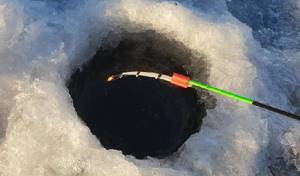
Ice fishing for crucian carp using a jig with a nozzle or bait is the main way to fish for this underwater inhabitant in winter. A bloodworm, a worm, an insect larva are placed on the bait hook, dough or pearl barley is placed, and the equipment is lowered to the bottom.
Recommended reading: How to look for perch in winter
In this case, the fish are attracted by the jig for its play and appearance, as well as the bait, which has a taste and smell. The crucian carp reacts to the movement of the bait under the hole at the bottom, approaches, tries it and decides to bite. All that remains is to do the hooking and landing.
Baitless fishing

Reelless is a catchy way of fishing for active fish. If crucian carp is active and readily responds to bait, then baitless fishing is the best choice in such conditions. This is exploratory fishing, during which you have to drill many holes, explore the water area, and select wiring.
The best nozzle jig for crucian carp is a small pellet weighing 0.2–0.3 grams. It is recommended to put a small bead of black, white, yellow or red on the hook and secure it with a piece of cambric of a contrasting color. This fish reacts well to devils, goats and small “bulls” models.
Float fishing
Fishing for crucian carp with a winter float rod is passive fishing that does not require active searching. It is assumed that the “penguin” knows the water area and the habits of local fish well. After drilling several holes with a distance of about 5 meters between them, they arrange the gear. After determining the most catchy point, they move to where they fish at the same time with 2-3 rods.
